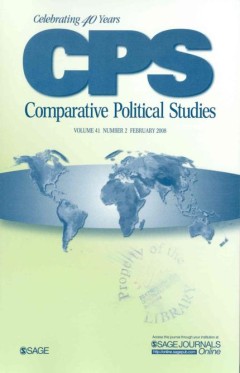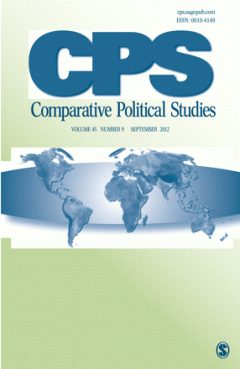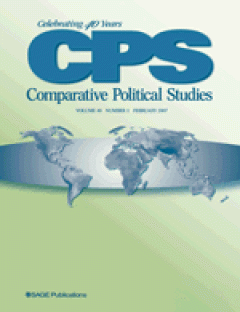Filter by

The Strategy of Paired Comparison: Toward a Theory of Practice
Paired comparison is a strategy of political analysis that has been widely used but seldom theorized. This is because it is often assimilated to single-case studies or regarded as a degenerate form of multicase analysis. This article argues that paired comparison is a distinct strategy of comparative analysis with advantages that both single-case and multicase comparisons lack. After reviewing …
- Edition
- Vol. 43, No. 2, Feb 2010. pp. 230-259
- ISBN/ISSN
- 00104140
- Collation
- -
- Series Title
- Comparative Political Studies
- Call Number
- -

Institutional Constraints on Profligate Politicians: The Conditional Effect o…
The literature on the common pool resource problem in budgeting has thus far not explored the likely interaction between size fragmentation (the number of decision makers) and procedural fragmentation (the structure of the process in which they interact).The argument put forward in this article is that the effects of these two types of fragmentation should not be additive, but multiplicative, b…
- Edition
- Vol. 43, No. 2, Feb 2010. pp. 208-229
- ISBN/ISSN
- 00104140
- Collation
- -
- Series Title
- Comparative Political Studies
- Call Number
- -

Personality and Political Tolerance: The Limits of Democratic Learning in Pos…
Can all citizens learn political tolerance through engagement in democratic politics? The lack of direct experience with democratic processes may account for a portion of the tolerance gap between mass publics in established and new democracies and suggests optimism about trends in tolerance within postcommunist Europe. Yet learning tolerance may be limited to individuals who are psychologicall…
- Edition
- Vol. 43, No. 2, Feb 2010. pp. 188-207
- ISBN/ISSN
- 00104140
- Collation
- -
- Series Title
- Comparative Political Studies
- Call Number
- -

Endogenous Oil Rents
Oil rents may at times fall like "manna from heaven" into the fiscal coffers of the state. Yet politicians also make decisions that can increase or decrease the extent to which oil rents accrue to the central government. Though counterintuitive, various evidence suggests that politicians sometimes do not seek to maximize the state�s claim on rents. In this article, the author substantiates this…
- Edition
- Vol. 43, No. 3, March 2010. pp. 379-410
- ISBN/ISSN
- 00104140
- Collation
- -
- Series Title
- Comparative Political Studies
- Call Number
- -

Political Scale and Electoral Turnout: Evidence From the Less Industrialized …
This article attempts to bring the politics of scale back into the study of comparative politics. Explicitly focusing on the question of electoral turnout in the less industrialized world, it explores the impact of variations in community size relative to other influences on citizen participation. The findings, which draw on both aggregate and individual-level data at the subnational level of a…
- Edition
- Vol. 43, No. 3, March 2010. pp. 275-303
- ISBN/ISSN
- 00104140
- Collation
- -
- Series Title
- Comparative Political Studies
- Call Number
- -

Death of the Partisan? Globalization and Taxation in South America, 1990—2006
Correcting the relative lack of attention to the revenue side of public finance, this article examines to what extent globalization constrains partisan tax policy. The author hypothesizes that political ideology is still a good predictor of taxation in the neoliberal era, advancing this argument against the prominent globalization thesis: that global economic pressures have supplanted political…
- Edition
- Vol. 43, No. 3, March 2010. pp. 304-328
- ISBN/ISSN
- 00104140
- Collation
- -
- Series Title
- Comparative Political Studies
- Call Number
- -

New Structuralism and Institutional Change: Federalism Between Centralization…
This article aims to contribute to the debate on institutional change by introducing social structure as the basis for theorizing about the direction of such change. The empirical context is the long-term trends of federal institutional change in the federations of the industrialized West (Australia, Austria, Belgium, Canada, Germany, Spain, Switzerland, and the United States). It is the author…
- Edition
- Vol. 43, No. 3, March 2010. pp. 353-378
- ISBN/ISSN
- 00104140
- Collation
- -
- Series Title
- Comparative Political Studies
- Call Number
- -

The Political Economy of Technological Innovation and Employment
Building on the varieties of capitalism thesis of comparative advantages in technological innovation, the authors theorize the effect of sociopolitical coordination from a dynamic perspective and then apply the dynamic theories to the political economy of employment, in comparison to the existing employment literature situated in a constant-technology context. Based on cross-sectional survey as…
- Edition
- Vol. 43, No. 3, March 2010. pp. 329-352
- ISBN/ISSN
- 00104140
- Collation
- -
- Series Title
- Comparative Political Studies
- Call Number
- -

Trading Places, The Role of the United States and the European Union in Inter…
When environmental issues emerged on the international agenda in the late 1960s and early 1970s, the United States was of one of the strongest and most consistent supporters of international environmental treaties and agreements. The member states of the European Union subsequently ratified all the international treaties created in this period, but U.S. leadership was crucial and European state…
- Edition
- Vol. 43, No. 4, April 2010. pp. 427-456
- ISBN/ISSN
- 00104140
- Collation
- -
- Series Title
- Comparative Political Studies
- Call Number
- -

Why No Backsliding? The European Union’s Impact on Democracy and Governance…
This article documents and explains the puzzling lack of backsliding in political reforms among the new postcommunist EU members, even though these countries are no longer subject to the powerful incentives of the EU membership promise. Using a combination of cross-national statistics, expert interviews, and public opinion data, the authors show that the new EU members have experienced at most …
- Edition
- Vol. 43, No. 4, April 2010. pp. 457-485
- ISBN/ISSN
- 00104140
- Collation
- -
- Series Title
- Comparative Political Studies
- Call Number
- -

Policy Uncertainty in Hybrid Regimes: Evidence From Firm-Level Surveys
Cross-national surveys suggest that regulatory and policy uncertainty is an important constraint on investment in developing countries. Yet there has been little direct empirical investigation of the sources of this uncertainty. This article presents evidence of an inverted U-shaped relationship between firms� perceptions of policy uncertainty and political regime type. Firms in hybrid regimes …
- Edition
- Vol. 43, No. 4, April 2010. pp. 486-510
- ISBN/ISSN
- 00104140
- Collation
- -
- Series Title
- Comparative Political Studies
- Call Number
- -

Serving Citizens: How Comparable Are Polish and Russian "Street-Level" Bureau…
An experimental survey on bureaucratic responsiveness in the social welfare arena in Poland and Russia shows that both countries� social welfare workers are capable of performing in a manner deemed helpful to local Polish and Russian citizens�a key component of effective governance. Such findings are surprising given an absence of reforms to create Weberian bureaucracies out of both countries� …
- Edition
- Vol. 43, No. 5, May 2010. pp. 578-605
- ISBN/ISSN
- 00104140
- Collation
- -
- Series Title
- Comparative Political Studies
- Call Number
- -

Why Respecting Physical Integrity Rights Reduces Terrorism
Does respect for human rights check or promote terrorism? This question is hotly debated within policy circles. Some hold that restricting human rights is a necessary if unfortunate cost of preventing terrorism. Others conclude that such abuses aggravate political grievances that contribute to terror. The authors demonstrate that theory and data support the latter position. They hypothesize tha…
- Edition
- Vol. 43, No. 5, May 2010. pp. 551-577
- ISBN/ISSN
- 00104140
- Collation
- -
- Series Title
- Comparative Political Studies
- Call Number
- -

Decentralization and the Development of Nationalized Party Systems in New Dem…
The extent to which a party system is nationalized�with nationalization being defined as the degree to which major political parties obtain similar vote shares throughout the national territory�has considerable consequences for political representation, public policy making, and even the survival of democracy. Yet, so far there is little empirical evidence about the conditions that promote or i…
- Edition
- Vol. 43, No. 5, May 2010. pp. 606-627
- ISBN/ISSN
- 00104140
- Collation
- -
- Series Title
- Comparative Political Studies
- Call Number
- -

When Are Concerted Reforms Feasible? Explaining the Emergence of Social Pacts…
Under what conditions do governments, employers, and unions enter formal policy agreements on incomes, employment, and social security? Such agreements, widely known as social pacts, became particularly prominent during the 1990s when European economies underwent major adjustment. This article seeks to explain national variation in adjustment strategies and specifically why concerted agreements…
- Edition
- Vol. 43, No. 5, May 2010. pp. 628-657
- ISBN/ISSN
- 00104140
- Collation
- -
- Series Title
- Comparative Political Studies
- Call Number
- -

Aid Effectiveness and the Politics of Personalism
This article examines how political institutions that provide an incentive to cultivate a personal vote condition the relationship between foreign aid and economic growth in developing country democracies. Politicians in aid-recipient countries with high levels of personalism are more likely to pursue corruption and target government spending to narrow constituencies. Because personalism affect…
- Edition
- Vol. 43, No. 6, June 2010. pp. 735-762
- ISBN/ISSN
- 00104140
- Collation
- -
- Series Title
- Comparative Political Studies
- Call Number
- -

Elections in Rural China: Competition Without Parties
Village elections in China present scholars with the case of a single-party regime that allows voters to reject candidates regularly. Using a micro survey of 698 voters in 30 rural election districts, the authors demonstrate that when some candidates can lose, voters participate. A comparison of models of voter turnout and running for office further demonstrates that even when competition is st…
- Edition
- Vol. 43, No. 6, June 2010. pp. 763-790
- ISBN/ISSN
- 00104140
- Collation
- -
- Series Title
- Comparative Political Studies
- Call Number
- -

The Politics of Inequality: Voter Mobilization and Left Parties in Advanced I…
Why is it that some countries have witnessed significant increases in inequality since the 1960s while at the same time experiencing very little change in the way politics is conducted? And why is it that in other countries, where inequality has increased much less, the Left has become substantially more redistributive? The answer, the authors argue, has to do with the interaction between inequ…
- Edition
- Vol. 43, No. 6, June 2010. pp. 675-705
- ISBN/ISSN
- 00104140
- Collation
- -
- Series Title
- Comparative Political Studies
- Call Number
- -

Revisiting the Single European Act (and the Common Wisdom on Globalization)
The European program of liberalization launched by the Single European Act (SEA) of 1987 is commonly seen as a powerful instance of "globalization" trends of economic integration, liberalization, and international institution building. This article revisits the origins of the SEA to argue that the extent and success of its liberalizing program depended on a causally distinct push for European i…
- Edition
- Vol. 43, No. 6, June 2010. pp. 706-734
- ISBN/ISSN
- 00104140
- Collation
- -
- Series Title
- Comparative Political Studies
- Call Number
- -

Class, Status, and Party: The Changing Face of Political Islam in Turkey and …
This article argues that socioeconomic changes within Islamist constituencies are critical parts of understanding of how moderate Islamists emerge and succeed. The diverging paths of economic reform in Turkey and Egypt have generated different effects on the Islamist constituencies in these two countries. Economic liberalization has played both a constitutive and a causal role in transformation…
- Edition
- Vol. 43 no. 7, July 2010, pp. 835-861
- ISBN/ISSN
- 00104140
- Collation
- -
- Series Title
- Comparative Political Studies
- Call Number
- -
 Computer Science, Information & General Works
Computer Science, Information & General Works  Philosophy & Psychology
Philosophy & Psychology  Religion
Religion  Social Sciences
Social Sciences  Language
Language  Pure Science
Pure Science  Applied Sciences
Applied Sciences  Art & Recreation
Art & Recreation  Literature
Literature  History & Geography
History & Geography